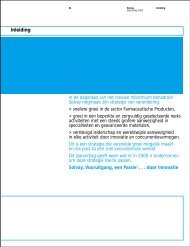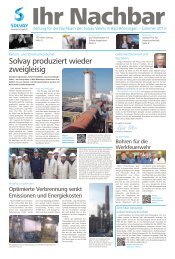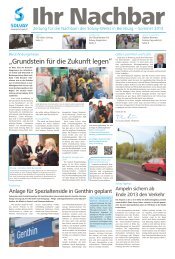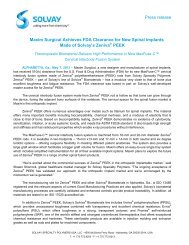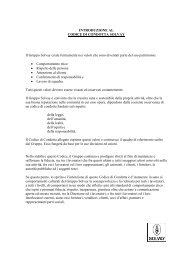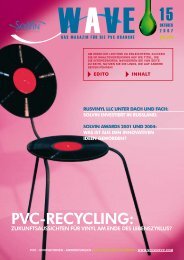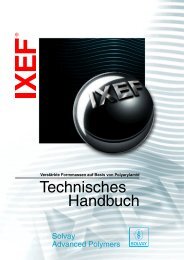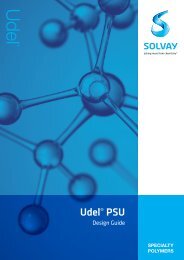Design Guide - Solvay Plastics
Design Guide - Solvay Plastics
Design Guide - Solvay Plastics
Create successful ePaper yourself
Turn your PDF publications into a flip-book with our unique Google optimized e-Paper software.
<strong>Design</strong> Information<br />
In this section, basic design principles and general<br />
recommendations are presented to assist the design<br />
engineer in designing plastic components that meet<br />
the cost/performance requirements of their applications.<br />
<strong>Guide</strong>lines are given on the effects of stresses caused<br />
by assembly, temperature changes, environmental<br />
factors, and time as it relates to creep.<br />
Of the various materials available to a design engineer,<br />
thermoplastics offer the greatest variety, versatility<br />
and freedom of design. <strong>Plastics</strong> can be translucent or<br />
opaque, rigid or flexible, hard or soft. Plastic materials<br />
are available that provide a wide range of chemical<br />
resistance, from chemically inert to selective solubility in<br />
certain environments. Broad versatility is also available<br />
for other properties like strength, stiffness and impact<br />
resistance, lubricity and thermal capability. Blends and<br />
alloys are possible that further increase the material<br />
choices for a particular application.<br />
At times, designing with plastics may appear more<br />
complicated than with metals. But the diversity of<br />
products, conversion processes, and secondary<br />
operations (welding, inserts, printing, painting,<br />
metallizing) available with plastics gives the designer<br />
unprecedented freedom as shown in Table 45.<br />
A designer may be tempted to make a plastic part that<br />
merely duplicates the dimensions of a metal part without<br />
taking advantage of the versatility of the plastic material<br />
or the design freedom offered. This approach can lead<br />
to inefficient designs or parts that are difficult to produce,<br />
or whose performance is less than optimal.<br />
The following sections discuss those areas of<br />
mechanical design and stress analysis that relate to<br />
designing with plastics, comparing metal to plastics and<br />
discussing factors that are specific to plastics alone.<br />
Table 45: <strong>Design</strong> Benefits of Amodel Resin<br />
over Metals<br />
Amodel Resin<br />
Characteristics<br />
Amodel resins are fabricated<br />
by the injection molding<br />
process, which allows<br />
substantial design freedom<br />
Amodel resins<br />
are thermoplastic<br />
Amodel resins resist<br />
chemicals<br />
Benefit in <strong>Design</strong><br />
Ribs, bosses, or cored<br />
sections can be readily<br />
incorporated.<br />
Snap fits can be molded in,<br />
simplifying assembly.<br />
Eliminate many secondary<br />
operations such as drilling,<br />
tapping, boring, deburring,<br />
and grinding.<br />
Metal inserts can be easily<br />
used where necessary to<br />
optimize part strength.<br />
Features from several metal<br />
parts of an assembly may be<br />
combined into a single part,<br />
simplifying assembly and<br />
reducing cost.<br />
Parts may be joined with<br />
ultrasonic or vibration<br />
welding rather than fasteners.<br />
Color may be molded-in<br />
rather than added afterward<br />
as paint.<br />
Parts will not rust, and resist<br />
corrosion.<br />
<strong>Design</strong> Information<br />
Amodel ® PPA <strong>Design</strong> <strong>Guide</strong><br />
63



